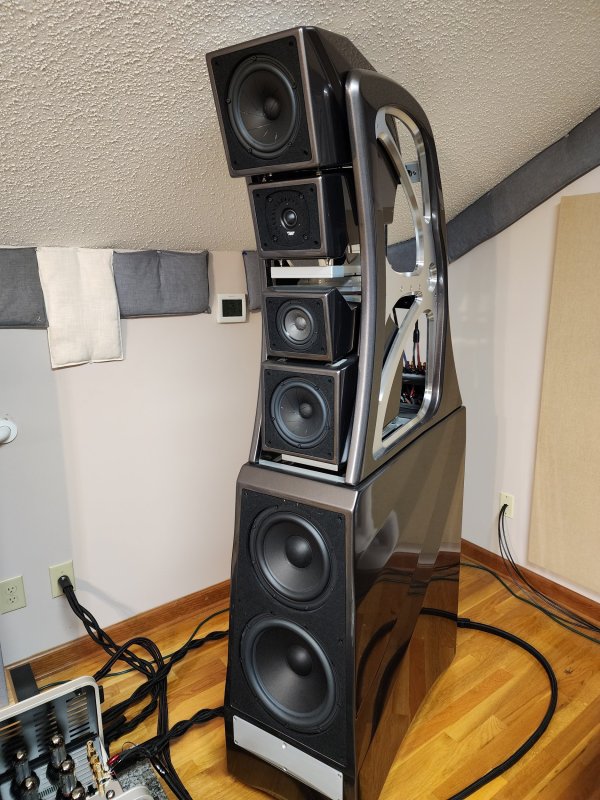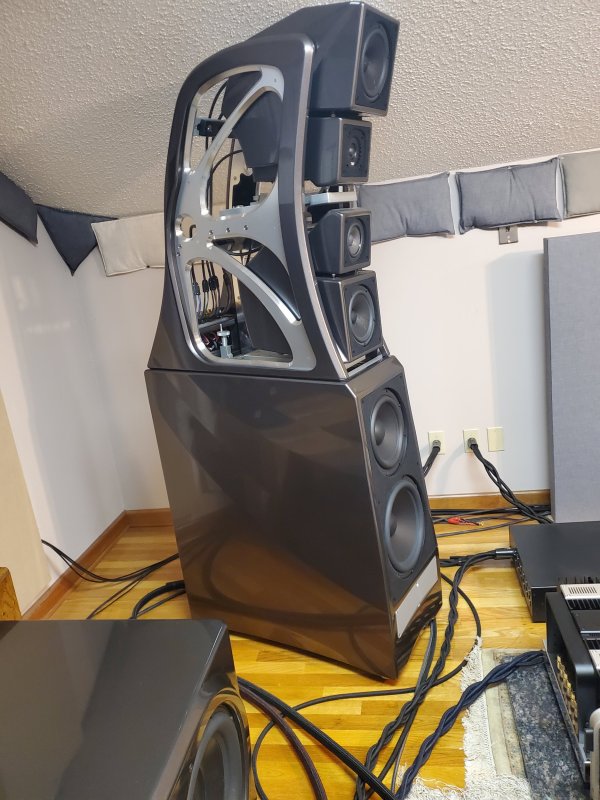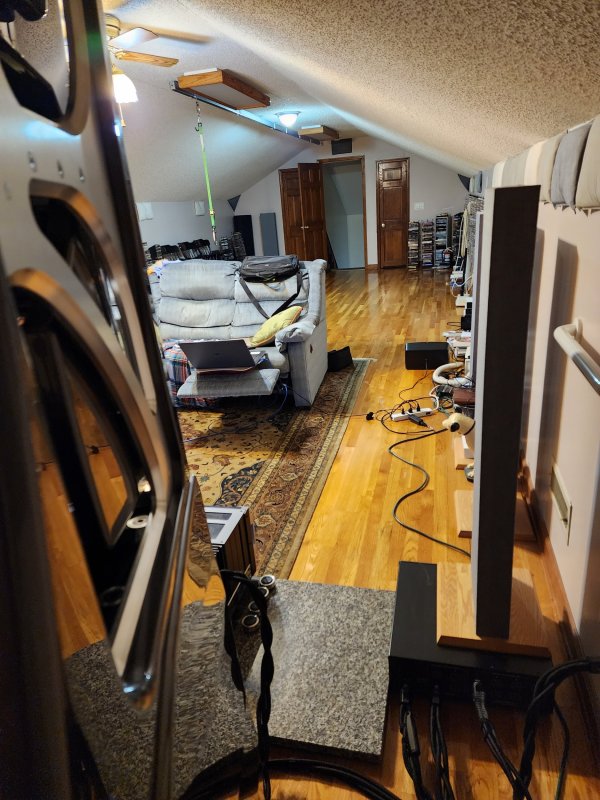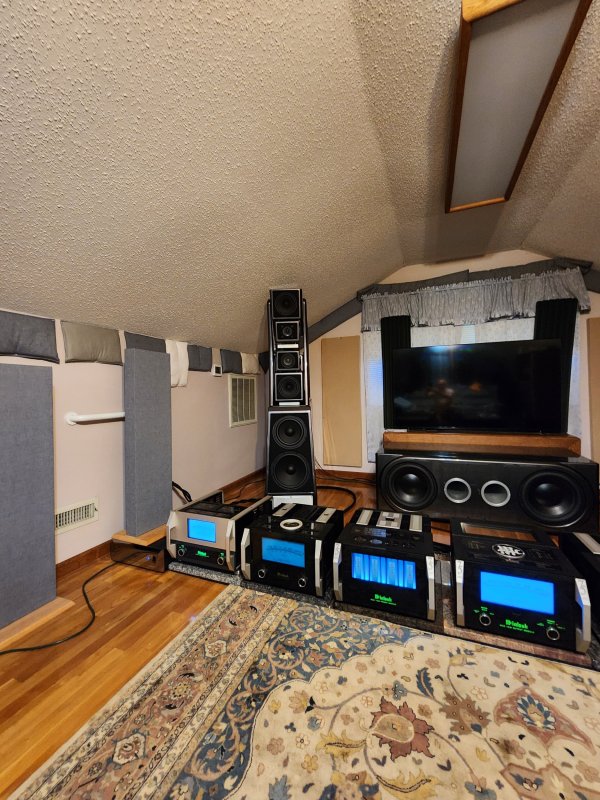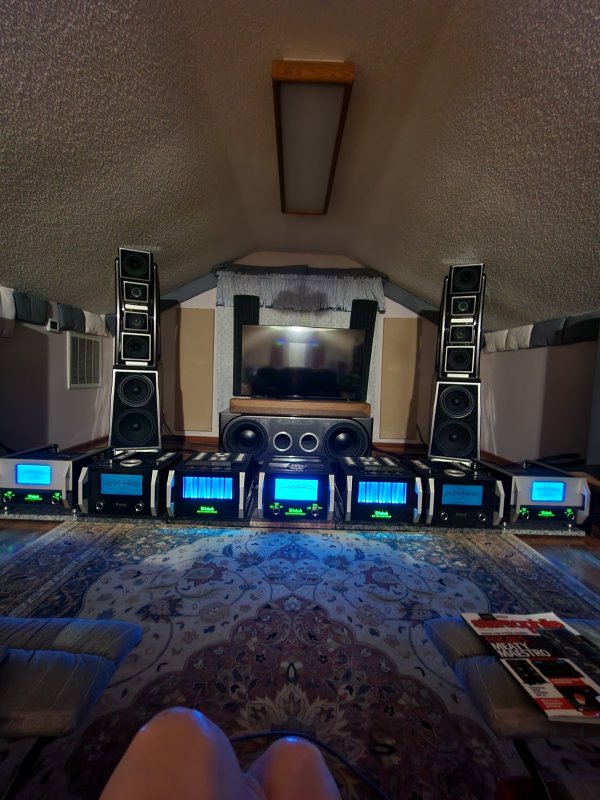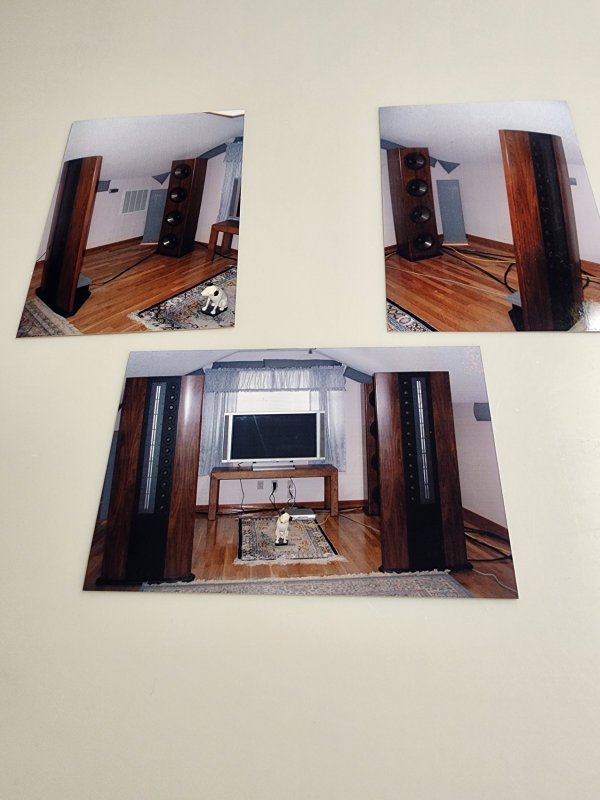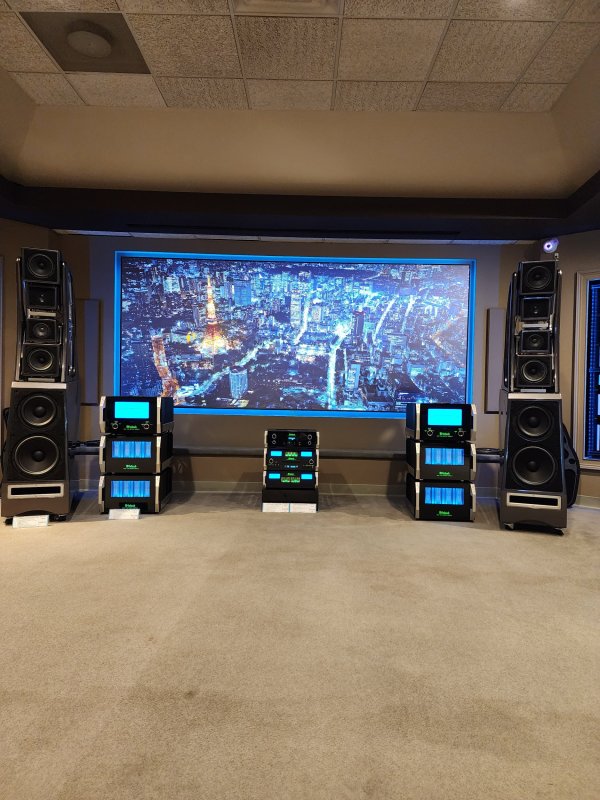I think you are right, i have take look at avaiable shematics of vtl.I think VTL uses true Tetrode mode or Triode, no UL.
Ron’s New System
- Thread starter Ron Resnick
- Start date
You are using an out of date browser. It may not display this or other websites correctly.
You should upgrade or use an alternative browser.
You should upgrade or use an alternative browser.
Thanks for the question. I have never measured it. It's almost exactly 30 inches and the corner is about 40 inches away from the rear of my speaker. Speaker depth is 33 inches. My room is 15.5 inches wide. A-Frame with an 8-foot ceiling heavily blown with popcorn for diffusion. It's a full 40 feet long and I leave the rear door open to let out the bass, so I have zero rear wall back wave. My ears are 11 feet from the tweeters, and I can just see the inner walls of my woofer cabinets. My tweeters are 9 feet (exactly 108 inches) apart. It's the classical Wilson setup. I'm in the zone of neutrality for voicing and I get great room bass reinforcement resulting in a strong smooth bass all the way down to 10 Hz with a bass boost of about 20 dB at 15-16 Hz. I'm probably subjectively plus 3-4 dB at 40 Hz, 6-10 dB at 30 Hz, 20 dB at 20 Hz boost from room reinforcement plus subwoofer volume setting.Charles S.,
You probably told us, but I can't find it in the XVX thread - what is the distance between the back of the XVX and the front wall in your system, as well as the length of your room ?
My tweeters are aimed directly at my ears with only 4 dB of super tweeter attenuation. This provides a beautiful pleasing sparkle to my treble that is never bright. The XVX super tweeter is seldom spoken of but is integral to my treble. My room is wall within wall construction, one double window behind my TV, built entirely of two by sixes and supported by 40 reinforced Lowe's wooden I-Beams. It's a fantastic room acoustically. It will support live performance levels without sounding loud. I believe in direct on axis listening. Most of you listen off axis. IMO, that's the great advantage of Wilsons, which is direct on axis listening, without sounding bright, because that's how Wilsons are designed, with the tweeters aimed at the ears.
As I have said, when I see a Wilson setup like what is at my dealer or Mike Fremer, it makes me wonder. I have strangely never bothered to hear my dealer's demo XVX, even though I'm responsible for their XVX. I guess I'll hear it this spring since I just received an email from Wilson. Their envoy will be giving my setup an audition and then we will be going to HiFi Buys, then hopefully out to dinner. The XVX in the showroom is way too close to the wall, IMO. I'll send a picture for comment. However, I believe the opposite is also true. When I see a Wilson speaker or any speaker 15-20 feet from the rear wall, I know there is zero bass reinforcement from the room. This can be a cause of brightness in a high-end system.
On WBF which is by far the most knowledgeable of all the forums, I don't hear much about subjective room frequency response. You all as professionals are almost 100% into nuances of ultra-high-end DAC's, amplifiers, etc., and academic but very interesting discussions of system brightness, etc. For a layperson like me, this forum is a dream come true. I can see how it would be quite boring and unintelligible to the average high ender.
For example, there's a 16 Hz note at about 4:16 of the first movement of Jongen: Symphonie Concertante Telarc CD 800096 Michael Murray organist that I'll bet a dollar to a nickel that is not audible in any of your systems, including the Gryphon Kodo in the Varese audition that Lee so successfully pulled off in another thread. I used to have Genesis II's with dual mono bass amps and huge 400-pound subs for 10 years. The note is not loud but would audibly distort the big subs if pushed too hard and barely audible through them. It takes about 25-30 watts through my Thor which renders the note with great authority and perfect precision. My Thor would do this note at 2K watts if required. Although I'm quite interested in nuance and precision, I'm equally interested in this high-end kind of high-end performance.
I already have a gorgeous treble and midrange without even a hint of brightness. I want what Arnie Nudell referred to as the "big bottom". Once you have experienced it you can never go back and believe me it acts to help reduce the brightness in any system. I'll include some pics when I go downstairs.
Charles
Charles Updated System: Wilson McIntosh Audioquest
Amps: McIntosh: MC3500MKII (2); MC1.25KW (2); MC2.1KW An
Preamp: C-12000 An
Sources: MCD12000 An; MVP881; MVP851; MR87; Marantz 510LV; Lenovo Yoga laptop
Speakers: Wilson Chronosonic XVX
Sub-Woofer: Wilson Thor’s Hammer; Wilson ActivXO Stereo Electronic Crossover
Cables Main System AQ: WEL Signature speaker cables; 24’ balanced IC; balanced 1-meter Dragon IC ; WEL Signature digital, Coffee digital coaxial cables; Diamond optical (2); Diamond USB; Dragon (5 HC, 3 source cords); Thunder & Monsoon power cords
Cables Subwoofer System AQ: Redwood speaker cable; Wolf balanced subwoofer IC; Wind balanced IC to ActivXO; Hurricane HC; Firebird HC; Firebird Source; Dragon HC, power cords
Power Conditioners: AQ Niagara 7000; Niagara 5000 (3); (4) dedicated 20-amp lines.
Isolation: Wilson Pedestals; Bassocontinuo McIntosh Ultra Feet; X-material plinth
Cabinet: Double Custom Woodwork & Design (CWD)
Acoustic Treatments: Room and Echo Tunes
Last edited:
Second to last pic is my old Gen II system that I had for 10 years. I love this system. Paid 30K for it. Someone from Atlanta came over to Old hickory to install it. He was a consummate professional. I will never forget him. What a job he did! The final pic is at my dealer. I never bothered to hear it. I don't know why.
Attachments
my Clarisys speakers
Do you have an impedance plot of your Clarisys speakers?
Thanks for the question. I have never measured it. It's almost exactly 30 inches and the corner is about 40 inches away from the rear of my speaker. My room is 15.5 inches wide. A-Frame with an 8-foot ceiling heavily blown with popcorn for diffusion. It's a full 40 feet long and I leave the rear door open to let out the bass, so I have zero rear wall back wave. My ears are 11 feet from the tweeters, and I can just see the inner walls of my woofer cabinets. My tweeters are 9 feet (exactly 108 inches) apart. It's the classical Wilson setup. I'm in the zone of neutrality for voicing and I get great room bass reinforcement resulting in a strong smooth bass all the way down to 10 Hz with a bass boost of about 20 dB at 15-16 Hz. I'm probably subjectively plus 3-4 dB at 40 Hz, 6-10 dB at 30 Hz, 20 dB at 20 Hz boost from room reinforcement plus subwoofer volume setting. (...)
Your room is similar to my previous room that had 32 feet length. In this room I had the XLF back 6 feet away from the front wall and listening distances comparable to yours.
The wall building technique is a fundamental aspect of speaker placement that few simulators can address - drywall can act as a bass trap, absorbing bass, thick stone walls reflect bass, creating peaks and nulls. My room had 2 feet thick stone walls - a real nightmare.
In fact, not all SET amps sound the same. I was hoping that that gorgeous TB3/1000 SET I hosted did not sound like a giant Lamm ML2.
I have never abandoned my "alternative fantasy amp" quest for a 100 watt SET or PSET that sounds like ML2 or Viva Aurora.
my Clarisys speakers
Assess whether amplifiers sound the same? That's not what I'm assessing. I assess which amplifier achieves greater suspension of disbelief and sounds more natural and convincing.
I am trying to understand your posts. Are you saying you would use your Clarisys speakers to assess whether or not a 100 watt SET or PSET “sounds like” an ML2? Do you think an ML2 could drive your Clarisys?
You first set up the scenario to find a powerful tube amplifier that sounds like an ML2. Now you seem to be saying that it would be a shootout to see which amplifier achieve greater suspension of disbelief and sounds more natural and convincing.
For sure they use feedback. I was not suggesting that VTL is anything other than Class AB. I was saying that the only PP amps I have heard that were close in sonic signature to SET are Class A triodes not using feedback. Usually with DHTs as output tubes (300B, 2A3, 845 or 211 etc.).With this distortion profile i think they run in class ab1, but i have not seen the shematics.
I would not do zero global feedback, you get a lot of gain and the amplifier becomes unstable (tendency to oscillate).
For sure they use feedback. I was not suggesting that VTL is anything other than Class AB (...)
Yes, but in fact, when used with medium efficiency speakers, the Siegfried will be playing class A all the time, except in these moments we have friends after a copious meal in our room ... The amplifier idle power is 600W.
With that many output tubes, it can easily be 600 watts and still be Class AB. It uses KT88s or? 12 of those use 120 watts just for heating (6.3V x 1.6A X 12), bias is about 60mA at around 560V or 35 watts per tube or 430 watts for the 12 of them...this is for Class AB1 bias in Tetrode. So, struggling to see where this amp will be Class A for more than a couple of watts...but this could be said of a lot of Class AB amps. That is not at all going to sound the same as an amp that is full on Class A all the time...just the typical behavior of a Class AB amp (thus why they are called Class AB and not Class B).Yes, but in fact, when used with medium efficiency speakers, the Siegfried will be playing class A all the time, except in these moments we have friends after a copious meal in our room ... The amplifier idle power is 600W.
It could actually drive the Clarisys, just probably not that loud. The load is not difficult and sensitivity is ok and as a line source it will have better "throw" into the room with less drop off with distance. I got very good sound from my Acoustats (nominally 84dB/watt) and a 30 watt KR Audio VA350i. I only had around 1dB drop in volume from the front of the speaker to my listening position because of the linesource nature. Played plenty loud without clipping or sounding distressed. Clarisys are an easier load and more sensitive than my Acoustats, so I expect that for moderate listening levels it should work.I am trying to understand your posts. Are you saying you would use your Clarisys speakers to assess whether or not a 100 watt SET or PSET “sounds like” an ML2? Do you think an ML2 could drive your Clarisys?
You first set up the scenario to find a powerful tube amplifier that sounds like an ML2. Now you seem to be saying that it would be a shootout to see which amplifier achieve greater suspension of disbelief and sounds more natural and convincing.
I also used to have a pair of Apogee Caliper Signatures, which were a tougher load and lower sensitivity than Ron's Clarisys but they did pretty well with a pair of Cary CAD572se monos, that made around 18 watts. Not for headbangers but made satisfactory in-room levels and did really wonderfully at lower volumes.
if you switch kt 88 into pseudo triode the amplifier has ~1/3 of the power. the screen grid is connected to anode so it becomes a triode. never forget the screen grid resistors they hold the tube to the bridle.With that many output tubes, it can easily be 600 watts and still be Class AB. It uses KT88s or? 12 of those use 120 watts just for heating (6.3V x 1.6A X 12), bias is about 60mA at around 560V or 35 watts per tube or 430 watts for the 12 of them...this is for Class AB1 bias in Tetrode. So, struggling to see where this amp will be Class A for more than a couple of watts...but this could be said of a lot of Class AB amps. That is not at all going to sound the same as an amp that is full on Class A all the time...just the typical behavior of a Class AB amp (thus why they are called Class AB and not Class B).
Yes, i have el 34 ( two)push pull in triode mode they sound close to 6c33 tube. The set amp a little more voluminous bass that all for ears.both 16 watt output powerFor sure they use feedback. I was not suggesting that VTL is anything other than Class AB. I was saying that the only PP amps I have heard that were close in sonic signature to SET are Class A triodes not using feedback. Usually with DHTs as output tubes (300B, 2A3, 845 or 211 etc.).
With that many output tubes, it can easily be 600 watts and still be Class AB. It uses KT88s or? 12 of those use 120 watts just for heating (6.3V x 1.6A X 12), bias is about 60mA at around 560V or 35 watts per tube or 430 watts for the 12 of them...this is for Class AB1 bias in Tetrode. So, struggling to see where this amp will be Class A for more than a couple of watts...but this could be said of a lot of Class AB amps. That is not at all going to sound the same as an amp that is full on Class A all the time...just the typical behavior of a Class AB amp (thus why they are called Class AB and not Class B).
In fact, considering the definition of class A the Siegfried II it is class A up to 90W - it is an high bias tube amplifier.
Class A / class AB is a poorly understood affair, as in practice it depends a lot on the impedance of the loudspeaker load.
It could actually drive the Clarisys, just probably not that loud. The load is not difficult and sensitivity is ok and as a line source it will have better "throw" into the room with less drop off with distance. I got very good sound from my Acoustats (nominally 84dB/watt) and a 30 watt KR Audio VA350i. I only had around 1dB drop in volume from the front of the speaker to my listening position because of the linesource nature. Played plenty loud without clipping or sounding distressed. Clarisys are an easier load and more sensitive than my Acoustats, so I expect that for moderate listening levels it should work.
I also used to have a pair of Apogee Caliper Signatures, which were a tougher load and lower sensitivity than Ron's Clarisys but they did pretty well with a pair of Cary CAD572se monos, that made around 18 watts. Not for headbangers but made satisfactory in-room levels and did really wonderfully at lower volumes.
Can we know what was the room size, separation of speakers and listening distance? Unless these details are known these interesting remarks are almost meaningless.
Interesting . . . but there's no way those amps were properly powering the Apogee drivers (unless maybe at low volume in a small room).CAT JL2 signature was pretty good but was handily dispatched by a pair of NAT SE2SE monos (211 based amps) on Apogee Grand panels (used full range like a Diva and with Diva xover).
I have never seen or heard VTL describe the Siegfried II this way.In fact, considering the definition of class A the Siegfried II it is class A up to 90W - it is an high bias tube amplifier.
Last edited:
Yes; relatively easy to drive, as it is a pretty flat resistive loadDo you have an impedance plot of your Clarisys speakers?
my room size was a bit over 20 sqm and listening distance was around 3 meters. Room size was about 5 long x 4.2 wide and ceiling of 2.4 high. Levels of probably 85-90dB peak.Can we know what was the room size, separation of speakers and listening distance? Unless these details are known these interesting remarks are almost meaningless.
As you know, I totally disagree with the idea that you need a lot of power for these speakers. The Grands were around 86 or 87dB sensitivity and with a line source and easy load (I think they are like a flat 5 or 6 ohms) you don't need more power than these two amps deliver. CAT makes 100 watts and NAT at least 70 watts...more than enough in a normal sized room...and not just for low volume. It worked and worked very well.Interesting . . . but there's no way those amps were properly powering the Apogee drivers (unless maybe at low volume in a small room).
| Steve Williams Site Founder | Site Owner | Administrator | Ron Resnick Site Owner | Administrator | Julian (The Fixer) Website Build | Marketing Managersing |


